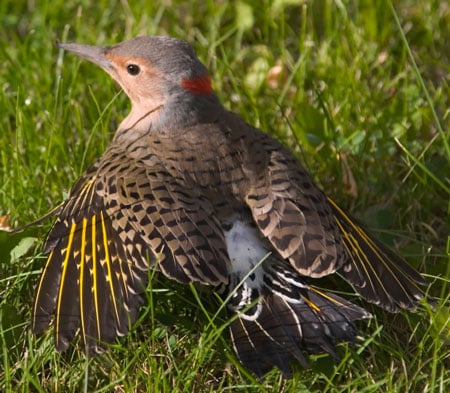Colaptes auratus
“WEEK-A-WEEK-A-WEEK-A!” Sounds like a woodpecker! Scan the tree trunks in the yard. No luck. That’s because this large woodpecker is likely on the ground pecking into the soil for ants! The Northern Flicker is in fact a ground-feeding woodpecker. Enjoy the antics as the bird forages his way across your lawn.
Northern Flickers are found across the North American continent during spring and summer months. The northern birds migrate south for the winter, but only into the southern states. There are two distinct subspecies: the Yellow-shafted Flicker is eastern and the Red-shafted Flicker is western. Hybridization between the two subspecies occurs where the two populations abut, along the eastern slope of the Rocky Mountains.
Notice the brown and black barring on the back and the spotted breast. The two most noticeable field marks are the black crescent-shaped bib across the breast and a white rump-patch seen as the bird flies away from you. Males have a black or red moustache-looking stripe originating at the bill base. This is absent on females. Also visible at close range are the red or yellow shafts of the flight feathers and the same colors on the surface of the underside of wings and tail.
Flickers are found along forest edges and thinly wooded areas. They frequently can be seen in towns and villages. Nests are located in cavities excavated each breeding season in dead wood. These homes get re-used in subsequent years by chickadees, nuthatches, titmice, and other secondary cavity-nesters. Have a dead tree still standing in your woodlot? Unless it is a safety issue, leave it alone as many species depend on these snags for house sites. Flickers are also important as primary predators of various ant species. In winter, flickers also consume fruits and the seeds of native herbaceous plants. While considered a common species, data from annual surveys suggests that the population of Northern Flickers is declining in the northeast. This is one more reason to preserve their habitiat, leave standing potential nest sites, and provide a food supply at your feeders.
While not frequent visitors to bird feeders, they are regularly reported at suet feeders and will also visit feeders stocked with a rich blend of sunflowers and nutmeats like Aspen Song® Nut & Fruit Woodpecker Mix.
Reference
Moore, William S. 1995. Northern Flicker (Colaptes auratus), The Birds of North America Online (A. Poole, Ed.). Ithaca: Cornell Lab of Ornithology.
